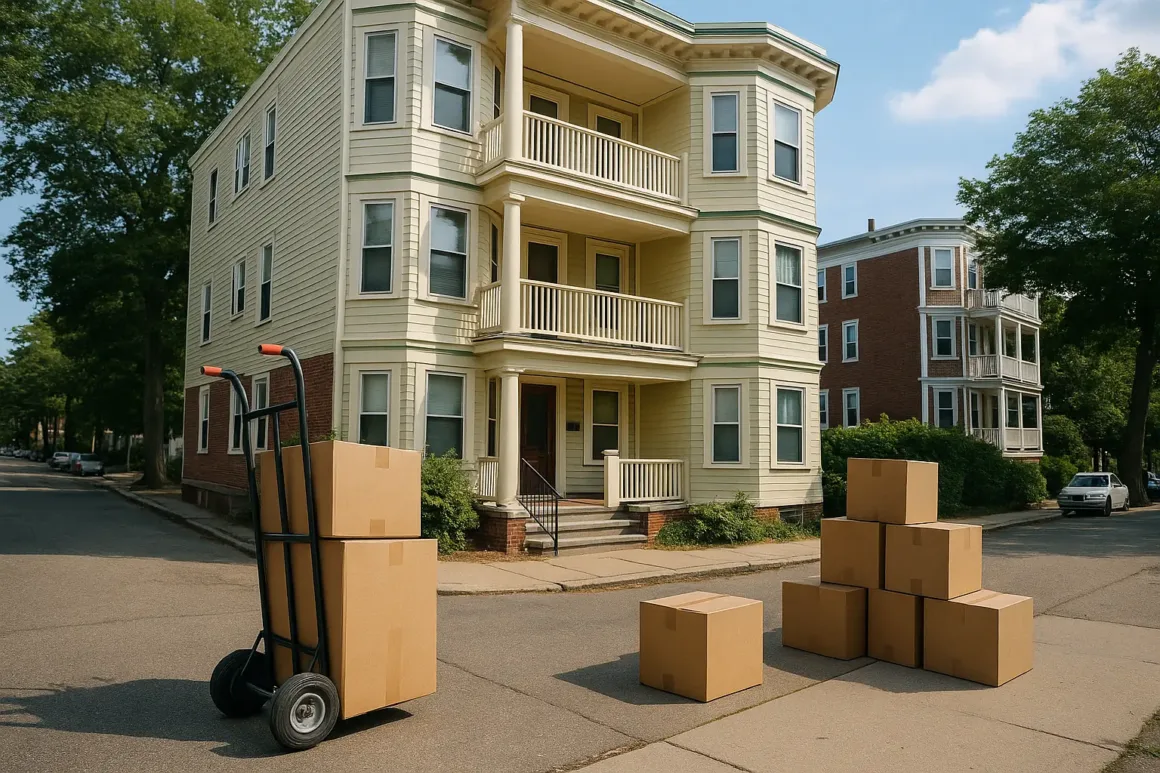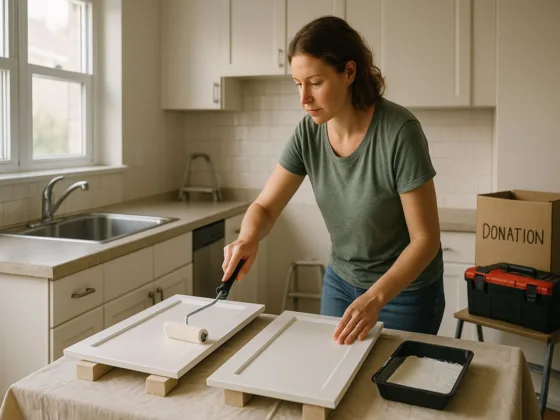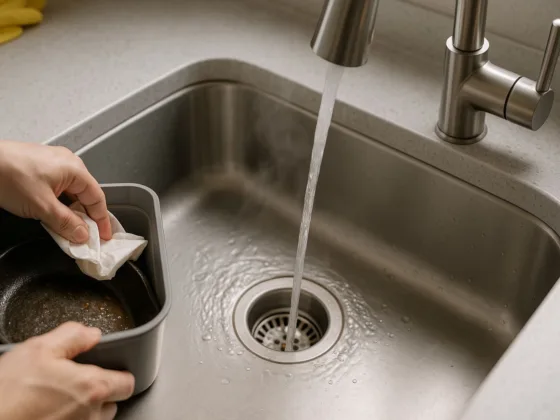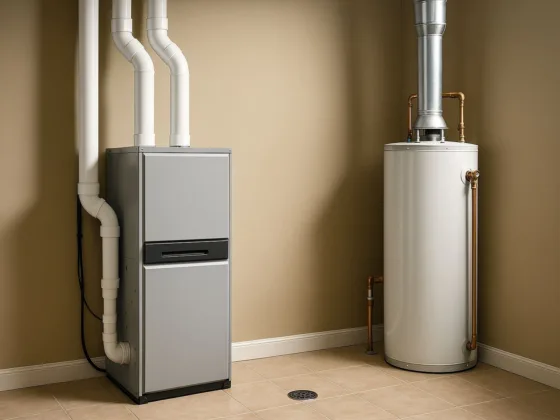Table of Contents Show
Quick Answer: A smooth move in Boston in 2025 comes down to three things: planning 4–6 weeks ahead, dealing with city logistics (parking permits, narrow streets, and busy move-in dates), and deciding early whether to hire professional movers or go DIY. As of late 2025, a standard one-day moving-truck permit for two non-metered spaces costs about $69, with metered spots adding about $40, so it’s smart to budget that in. Reserve a moving-truck parking permit through the City of Boston, compare quotes from licensed movers in Boston, and follow a simple room-by-room checklist so unpacking in your new place feels calm instead of chaotic.

Why Moving in Boston Feels Different (and How to Beat the Stress)
If you’re moving to a new place in Boston, the process is always emotional, but the city adds a few twists: tight one-way streets, older walk-up buildings, small apartments, and specific rules around moving-truck parking permits. The city even has its own famous “Moving Day” around September 1, when thousands of leases turn over at once and streets fill with moving trucks and discarded furniture—locals call it “Allston Christmas.”
Picture a typical Boston move: a grad student leaving a third-floor walk-up in Allston for a smaller place in Cambridge. She assumes she can just park a friend’s pickup on the street, but spends the first two hours circling for a spot and ends up with a parking ticket. That kind of headache is exactly what a simple moving-truck permit and a basic checklist are designed to prevent.
None of that has to overwhelm you. With the right checklist, you can arrive in your new Boston place with your boxes intact, your utilities working, and your stress level surprisingly low. This 2025 checklist for moving to a new place in Boston is designed to keep you focused on the steps that matter most so you’re not scrambling at the last minute.
If you’re planning anything from a small studio move to a family apartment swap, this guide will walk you through the major steps—and link to deeper resources like a detailed moving-out-for-the-first-time checklist and moving cost breakdowns.
Step-by-Step Boston Moving Checklist
Whether you’re upsizing, downsizing, or just changing neighborhoods, treating it as a project and following a clear sequence is the easiest way to make moving to a new place in Boston feel manageable.
4–6 Weeks Before Moving Day: Set the Foundation
Start early so moving week doesn’t turn into a frantic scramble. About a month out, you can begin laying the groundwork:
- Confirm your move-in and move-out dates. Double-check your lease so there’s no gap or overlap.
- Decide: DIY or professional movers? If you’re considering movers, start getting quotes now. Compare at least three companies and check their reviews and licenses.
- Create a master inventory. Walk room by room and list what’s coming with you, what you’ll donate, and what you can sell.
- Start decluttering. The fewer boxes you move, the cheaper and easier it gets. Donate or sell items you don’t love or use.
- Collect packing supplies. Get sturdy boxes, packing tape, markers, and cushioning (bubble wrap, paper, or towels).
For a more in-depth planning guide, check out this cross-country moving checklist—even if you’re just crossing town, a long-distance mindset helps you stay organized.
2–3 Weeks Before: Lock in Boston Logistics
- Apply for a moving-truck parking permit. In many neighborhoods, you must reserve curb space for your truck through the City of Boston, especially on narrow streets or in metered zones. As of 2025, a standard one-day permit for two non-metered spaces costs $69 and includes two “No Parking” signs, and reserving two metered spaces adds $40, so typical totals fall in the $69–$109 range.
- Confirm elevator and loading access. If you’re moving into an elevator building, ask your landlord or manager if you need to reserve the freight elevator or loading dock.
- Update key accounts. Submit address changes for your bank, credit cards, insurance, employer, subscriptions, and any deliveries.
- Schedule utilities. Arrange start/stop dates for electricity, gas, water, and internet so you’re never stuck in a dark, Wi-Fi-free apartment.
- Begin packing non-essentials. Seasonal clothes, décor, books, and rarely used kitchen gear can all go into boxes now.
If saving money is a priority, pair this plan with these money-saving moving tips.
1 Week Before: Pack Smart, Not Just Fast
- Pack room by room. Label each box with:
- Room (e.g., “Kitchen”),
- Short description (“Pots & pans”), and
- Priority level (1 = open first).
- Use soft items as padding. Wrap fragile pieces in towels, bedding, or clothing to save on bubble wrap.
- Keep heavy items low. Place books and cookware at the bottom of boxes and lighter things on top.
- Create a “First Night” box. Pack sheets, basic cookware, toilet paper, toiletries, a change of clothes, and a few snacks in one clearly labeled box.
- Prepare appliances. Defrost and clean your freezer, secure washer hoses, and tape down loose parts.
For more detailed packing tactics, see Painless Packing Pointers: Simplifying Your Big Move.
Moving Day: Stay Calm and Follow the Plan
- Start early. Boston traffic and street congestion are much easier to manage earlier in the day.
- Wear practical clothes and shoes. Expect stairs, tight corners, and possibly wet sidewalks.
- Assign simple roles. One person stays at the truck, one directs furniture inside, and one double-checks each room before it’s “done.”
- Keep essentials with you. Carry documents, keys, medicine, electronics, and anything irreplaceable yourself.
- Do a final sweep. Before locking your old place, check closets, cabinets, behind doors, under sinks, and inside appliances.
Boston-Specific Moving Logistics: Permits, Streets & Timing
Do You Really Need a Boston Moving-Truck Permit?
When you’re moving to a new place in Boston, you can’t simply park a moving truck outside your building and hope for the best. The City expects you to reserve space for your truck through a temporary moving permit—especially in dense or metered areas.
Here’s the usual process (always confirm on the official City of Boston website before you apply):
- Apply online or in person at City Hall. Online applications generally must be submitted at least two weeks before your move, and in-person applications at least three days ahead.
- Pay a base fee plus any extras for metered spaces.
- Post official “No Parking” signs in advance so cars don’t take your reserved curb space.
As of the City’s late-2025 guidance, a standard one-day moving-truck permit for two non-metered spaces costs $69 and includes two official “No Parking” signs. Reserving two metered spaces adds $40, bringing a typical total close to $109 for a one-day permit, so it’s worth factoring that into your 2025 moving budget.
By contrast, one couple moving from Jamaica Plain to South Boston reserved a moving-truck permit two weeks ahead, posted the official “No Parking” signs, and had a reserved curb space waiting for them. Their movers parked once, loaded and unloaded in one shot, and finished before lunch—no tickets, no blocked hydrants, and no angry neighbors.
Because the rules and costs can change, always rely on the latest guidance from the City of Boston’s official moving resources and permit pages.
Choosing the Best Time to Move in Boston
Boston has its own “high season” for moving. Most leases renew around September 1, and estimates suggest roughly two-thirds of city leases turn over that day, turning late August and early September into a city-wide moving festival (sometimes called “Allston Christmas”). Streets are packed with trucks and discarded furniture, and parking is even more competitive than usual.
If you have flexibility, consider:
- Mid-month or mid-week moves to avoid the peak congestion of weekends and the first of the month.
- Non-September move-in dates to dodge the city-wide rush.
- Weather. Winter moves are doable but bring snow, ice, and slushy sidewalks; summer moves can be hot and humid.
Dealing with Small Apartments, Stairs, and Old Buildings
Boston’s housing stock includes plenty of historic buildings, triple-deckers, and compact apartments. Newer units are often small, too—many of the city’s modern rentals are under 800 square feet, which means you’ll need to be strategic about what you bring.
That has a few practical consequences for your move:
- Measure everything. Confirm that your sofa, bed frame, and large furniture fit through stairwells, hallways, and doorways.
- Disassemble when possible. Take legs off tables, remove shelves, and separate sectional sofas.
- Think vertical storage. Plan for shelves, under-bed storage, and multi-purpose furniture in your new place.
If you’re moving from a larger home into a compact city apartment, this guide to apartment organization ideas can help you maximize every inch of space.
Should You Hire Professional Boston Movers or Go DIY?
There’s no single right answer, but if you’re moving to a new place in Boston, the city’s layout and parking rules push many people toward professional movers—especially if you have lots of furniture or are moving in or out of busy central neighborhoods. Local movers in Boston deal with these challenges every day, which can save you time, stress, and the risk of parking tickets.
Benefits of Hiring Boston Movers
- Local experience. Pros know which streets are difficult, when to avoid traffic, and how to handle tricky staircases.
- Speed and safety. A trained crew can usually load and unload faster and with less risk of damage.
- Help with permits. Some companies can advise you on parking permits or even handle signage for you.
- Clear responsibilities. When properly licensed and insured, movers must follow consumer-protection rules and provide certain documents, including your rights and responsibilities.
For a deeper dive into the pros of going pro, see 17 reasons to hire a moving company.
If You DIY Your Move
- Reserve your truck early. Around peak move-in dates, rental trucks and vans can sell out quickly.
- Confirm where you can legally park. Check with your landlord and the City of Boston to see if you need a temporary permit.
- Enlist enough help. Boston walk-ups are no joke—build in extra time and people for stairs.
- Protect your back (and your walls). Use lifting straps, blankets, and corner protectors.
Not sure which route will cost less? This guide on how much moving really costs can help you compare options.
Packing & Unpacking Tips That Make Boston Moves Easier
One of the easiest ways to reduce chaos when you’re moving to a new place in Boston is to pack with the first week in mind instead of just cramming items into boxes.
Organize by Category, Not Just by Room
Instead of tossing mixed items into random boxes, pack by category:
- Everyday kitchen basics (plates, cups, one pan).
- Bath essentials (towels, toiletries, toilet paper).
- Work setup (laptop, charger, basic office supplies).
- Seasonal clothes and shoes.
This keeps your first week in the new place functional, even if some boxes stay unopened for a while.
Make Unpacking in a New City Feel Less Overwhelming
Once you arrive, clean each room lightly before you start unpacking. Then follow this simple order:
- Bedroom: Assemble the bed and make it—sleep is your priority.
- Bathroom: Set up towels, shower curtain, and toiletries.
- Kitchen: Unpack enough to cook simple meals or at least make coffee.
- Living room: Arrange seating and a small “landing zone” for keys, mail, and daily items.
Many new Bostonians find that this order makes the first night feel much calmer. For example, one renter who moved into a Beacon Hill studio said that simply having her bed made, shower set up, and a small coffee corner ready on day one made the tiny apartment feel like “home” instead of a storage unit full of boxes.
These steps mirror the approach in this first-time moving checklist, which is helpful even if this isn’t your first move.
Settling Into Your New Boston Neighborhood
Moving to a new place in Boston isn’t just about boxes—it’s about feeling at home in a new city.
- Walk your block. Find your nearest grocery store, pharmacy, laundromat (if needed), and MBTA stops.
- Bookmark local resources. Save the city’s trash and recycling info, parking rules, and neighborhood pages so you’re not guessing later.
- Unpack faster than you think you “need” to. A put-together apartment makes the whole city feel more welcoming.
Give yourself one or two “no-box evenings” in the first week, where you ignore the unpacking and just walk the neighborhood. Grab a coffee, ride the nearest T line a few stops, or try a local takeout place. Many new residents say these little rituals—like a first Saturday morning walk through the Public Garden or a sunset stroll along the Charles—are what make Boston feel like their city, not just a temporary stop.
For more ideas on making a new city feel familiar, this guide on getting to know your new city after a move is a great next read.
Boston Moving Day: Quick FAQ
How far in advance should I book movers in Boston?
For regular times of year, aim for 3–4 weeks in advance. Around September 1 and other peak dates, book 6–8 weeks ahead if you can, since trucks and crews are in high demand.
How much does it cost to move within Boston?
Local moves are usually priced by the hour. Your total depends on how much stuff you have, how many stairs are involved, and how long it takes to load, drive, and unload. Add in the cost of a moving-truck permit and supplies like boxes and tape. For more detailed cost breakdowns, see this moving cost guide.
Do I always need a moving-truck permit?
Not always, but in most dense neighborhoods, metered areas, or spots with resident-only parking, a temporary permit is strongly recommended or required. It reduces the risk of tickets, towing, or having nowhere to park your truck. Always check your specific address on the City of Boston’s moving resources pages.
How can I avoid moving scams?
Whether you’re moving across town or across state lines, always:
- Verify that your mover is properly licensed and insured.
- Check their physical address and read independent reviews.
- Be cautious of large deposits or vague estimates.
The Federal Motor Carrier Safety Administration’s Protect Your Move resources explain your rights, how to check mover registration, and how to avoid common scams.
What if I’m moving with kids or a lot of family responsibilities?
Moving with kids in a busy city adds extra layers—school enrollment, routines, and emotions. It helps to involve them in small choices and keep a few familiar routines going. For ideas you can adapt to Boston, see these tips for moving with kids and busy-parent moving strategies.
- Author: Perla Irish, Home & Moving Writer at Dream Lands Design. Perla specializes in practical, step-by-step guides on moving, downsizing, and small-space living, and has helped develop multiple city-moving checklists for older East Coast housing markets.
- Reviewed by: Dream Lands Design Editorial Team, which reviews all moving and relocation content for clarity, accuracy, and alignment with current consumer-protection guidance and official city resources (including the City of Boston’s 2025 moving and parking-permit rules).
Helpful References & Resources
- City of Boston – Moving Resources
- City of Boston – Moving Truck Permit Portal
- City of Boston – Reserve a Parking Spot for Your Moving Truck
- FMCSA – Protect Your Move
- Boston Magazine – Moving Season Guide
- Boston.com – Why Does Everyone in Boston Move on September 1?
- CORT – Boston Moving Guide
With the right preparation—and a checklist that fits Boston’s 2025 rules and quirks—moving to a new place in Boston can feel less like a scramble and more like the start of a great new chapter.








